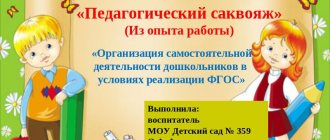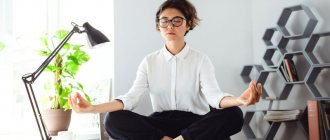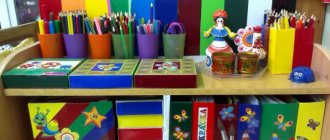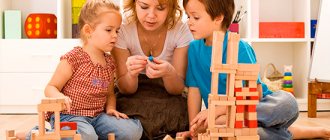Organization of independent motor activity of preschool children in preschool educational institutions
Korotkova Svetlana
Organization of independent motor activity of preschool children in preschool educational institutions
Organization of independent motor activity of preschool children in preschool educational institutions.
“It gives a child great pleasure if he himself noticed and clarified some phenomenon for himself, and if his reasoning turned out to be really correct, in the same way it gives him the greatest pleasure what he did himself and achieved without the instructions of others.”
P. F. Lesgaft
The harmonious development of a child is impossible without properly organized and sufficient motor activity for preschool , which has a huge impact on the health and physical development of the child. However, according to modern data, children move half as much as the age norm. Intellectual overload, a decrease physical activity both in volume and intensity, and its monotonous content are the main causes of neuropsychic and somatic diseases in preschool . All this gives rise to changes in the emotional sphere. Independent motor activity of children , about the benefits of which much has been written, is an excellent means of physical and emotional development of the individual.
Independent motor activity is an activity that occurs on the child’s initiative. According to physiologists, children in this type of activity satisfy their need for movement to a greater extent than for organized activities . The content of independent motor activity is a variety of movements. Its advantage is that the child himself chooses the type of movement, pace, pauses, and alternates them. This form of work requires special, indirect leadership.
The motor regime in kindergarten consists of organized and independent motor activity . Their percentage is different in groups of early, junior and senior preschool age . However, independent movements of children of all ages should account for at least 2/3 of the volume of their total physical activity . Management of independent motor activity provides for the following mandatory points:
-organization of a physical education and play environment: sufficient space for movement; optimal quantity, variety, rotation of benefits;
- fixing time in the daily routine for independent motor activity of children without fail during the morning reception, before and between classes, during a walk, after sleep, in the evening;
(indirect) educators
methods of activating children's movements.
All guidance is based only on an individual approach. Required:
-observe children, be able to see everyone and, if necessary, provide assistance;
- provide each child with a place to move, so that no one interferes, and protect this space;
-involve children in placing physical education aids in the group, on the site, thereby stimulating the desire to perform certain movements;
-relieve tension and constraint of individual children with a smile and encouragement; if the child finds it difficult, help him choose a movement aid with a question, riddle, or advice;
- try to unite children of different mobility in joint pair play without imposition, giving them one object for two (ball, hoop, jump rope, etc.)
and showing options for action if necessary;
- when introducing a new object, show it first of all to sedentary children, accompanying the demonstration with simple active movements and movements in space, to children of great mobility - movements that require accuracy, restraint, caution (walking, running, rolling a ball on a limited plane; all types of climbing and so on.);
- give preference to benefits that require active action, change their location more often, ensure rotation not only during the week, but also during the day;
- never force an active child to sit down; on the contrary, with the help of a plot, bring purposefulness into his aimless actions;
- sometimes engage in joint play with one of the children in order to show new movements or actions, to arouse interest in them;
- play with new aids, showing how differently you can act with them. For example: on the board - walk, run, jump, crawl, roll the ball; You can twist the rope together, make a path, a circle out of it, and then perform different movements; ball - rotate in place, roll, toss, throw, hit, play together, etc.;
“obstacle courses” with children
from the available benefits and encourage them to overcome them
“in different ways”
;
-enrich children’s role-playing games with a variety of types and methods of all basic movements.
The importance of this form of physical education for preschool children is undeniable . Independent activity , developing in children the ability to choose and perform (without the help of adults)
physical exercises, at the same time fosters initiative, activity,
organizational skills , and creative activity . For example, younger preschoolers already in the middle of the school year (due to systematic work in this direction)
are able to
independently come up with new movements and exercises with known manuals; older preschoolers - enrich familiar outdoor games with a large number of options, as well as create new ones.
All kindergarten students, regardless of age, can engage in physical exercise independently, individually and in small groups . The material is those exercises that, without requiring complex organization and insurance , most effectively affect the child’s body : crawling, exercises with a ball, jumping over a long and short rope, throwing at a target, running; cycling, swings, carousels and scooters , badminton, tennis, serso, ring throwing, outdoor and other games.
to manage independent motor activity carefully, tactfully, unobtrusively: encourage, encourage, suggest. Without hindering children’s initiative, direct the activities of each child and monitor the entire group at the same time. For example, children who have been jumping rope for a long time should be offered to play skittles, surf or other calm games; support children in unsuccessful attempts and ask for help from those who are more successful in this type of movement.
Thus, proper organization of independent motor activity will help improve health, expand motor experience , develop a strong interest in physical exercise, skills of self-organization and communication with peers, and develop creativity.
Bibliography
1. Demidova E. Organization of independent motor activity of children // Preschool education , 2004, No. 1
2. Medvedeva, T. Active activities of older preschoolers / T. Medvedeva // Preschool education , 2006, No. 8
3. Nikitina M. A. Innovative technologies for organizing motor activity of older preschool children / Nikitina M. A., Khramtsov P.I. - M., 2009
4. Runova M. A. Motor activity of a child in kindergarten: a manual for teachers of preschool institutions , teachers and students of pedagogical universities and colleges / Moscow: Mosaic - Synthesis. 2000.
5. Khvastunova, T. A. Organization of a subject-development environment in accordance with modern requirements / T. A. Khvastunova // Preschool educator, 2009, No. 2
MAGAZINE Preschooler.RF
Independent motor activity of children in a group roomInstructor – methodologist Berezhnova E.N.
The main causes of neuropsychic and somatic diseases in preschool children are intellectual overload and a decrease in motor activity, both in volume and intensity. Its content also becomes monotonous.
All this gives rise to changes in the emotional sphere. The phenomenon of “dried heart” (lack of feelings), which was observed by L.S. Vygotsky, among his contemporaries, is associated “with education aimed at logical and intellectualized behavior . Unfortunately, this phenomenon is still relevant today.
Independent motor activity of children, about the benefits of which much has been written, is an excellent means of physical and emotional development of the individual. Let us dwell in more detail on the characteristics of the conditions for the development of movements of preschoolers in different age groups.
Younger age
A child of two or three years old is actively exploring the world, using for this a still small reserve of movements: crawling, climbing, climbing, throwing, rolling, etc. His movements are not yet coordinated, steps when walking and running are mincing and noisy, there is no coordination in the work of his hands and legs, with sudden movements he often falls. But how many positive emotions the little explorer receives from satisfying the need for movement given to him by nature!
The first task of the teacher is to choose the right physical education and gaming equipment. It is necessary to proceed from what basic types of movements should be developed at this age: walking and running, balance and coordination, jumping on the spot (at two years) and jumping from a height (at three years); rolling, rolling and throwing the ball; crawling, crawling under arches, climbing into a box, onto a cube, climbing over a log, climbing a stepladder, etc.
In this regard, for independent motor activity of children in a group room, it is advisable to have the following set of physical education equipment and small equipment:
- smooth board (length 1.5 m, width 20 cm);
- gymnastic bench (length 2 m, height 15 cm, width 20 cm);
- ribbed board (length 1.5 m, width 20 cm);
- two arcs for climbing and rolling balls (height 50 cm, width 50 cm);
- two cubes (edge 25-30 cm);
- drawers for climbing (height 20, 15 and 10 cm, width and length respectively 50, 47 and 44 cm);
- step ladder (height 1.5 m);
- balls (diameter 6-8 cm, 10-15 cm, 20-25 cm) - five of each size;
- one or two inflatable balls (diameter 40 cm);
- rolling toys (two sets of different types);
- log (length 1.5 m, diameter 20 cm);
- health and preventive path (fine gravel, footprints, fabric of different textures, massage mats, etc.);
- large toys on wheels (at least four);
- cord (length 10 m, diameter 10-12 mm);
- rattles, rings, plumes, ribbons, flags - according to the number of children;
- four gymnastic sticks (length 75-80 cm);
- gymnastic pole (length 1.8-2 m).
Multifunctional modular sports and play equipment - a transformer - is optimal for the development of a child’s motor sphere. “Cubes” manual is interesting and useful for the comprehensive development of movements .
The equipment must be bright, attractive, meet hygienic requirements and safety rules. The teacher is obliged to check the stability and reliability of the equipment. This is especially true for swings, slides, and ladders, which are used only with an adult’s safety net.
The second task is to correctly place physical education and gaming equipment. Often, educators, in an effort to zone the playroom, place equipment in a specific safe place (in a drawer, box, on a rack, etc.). We believe that this is not entirely advisable for the following reasons.
Firstly, children's behavior is involuntary and situational. Comprehending the basics of movements, they study the properties of various objects and toys that fall into the area of their attention. For example, a child will be interested in a musical hammer until he notices a rotating inflatable ball mounted on the ceiling. Having accidentally stumbled upon a box with rings, the child will try to fit into it, and when he finds the details of the pyramid here, he will try to assemble the structure.
Secondly, children aged two or three always imitate their peers. Therefore, when he sees how enthusiastically another child plays with a ball or fervently runs around the group room with a rolling toy, he will definitely want to follow his example.
Physical education equipment for a child is the basis for learning how to use it. Place equipment and small inventory around the perimeter of the room in safe areas, modeling the trajectory and nature of the children’s movements. Try to ensure that the child does not have difficulty finding the item he needs. The object itself should stimulate and at the same time suggest a way to perform actions with it or on it.
Creating game situations ( “a bear sitting on a gurney” , “a kitten stuck on the top rung of a stepladder” , “a car located under an arc-garage” , “a bunny sitting on a ribbed board” ) will be a powerful incentive to repeatedly perform motor skills. actions with toys.
Of course, there is no need to turn your playroom into an equipment storage area. However, it is important that the inventory fits logically into the interior of the room, and change its location once or twice a week, combining several items into a single obstacle course.
Thus, in the first and second junior groups it is not advisable to create a special physical education corner. The entire room should be a single movement space in which each child can satisfy his need for movement, acting with a variety of physical education and play aids.
Middle group
According to research, in the fifth year of life, preschoolers experience a significant increase in motor activity indicators. The child becomes more mobile and seems tireless. However, its capabilities are still small. He is poorly oriented in space and is not dexterous enough, so careful control over the intensity and content of his independent motor activity is necessary.
Since physical education classes in the middle group are held in the gym, there is no need to keep all the equipment in the group room. We recommend setting up a special physical education corner for children to practice independently. The optimal place for such activities is an area away from windows, closets, and a corner of wildlife. Niches, shelves, hooks, drawers, carts and other options for placing equipment must meet hygienic and pedagogical requirements, and the equipment itself must meet the principle of expediency. For example, the Darts should be placed at the child’s eye level, foot massagers should be placed in a niche on the floor, etc. The physical education corner should logically fit into the interior of the room, harmonizing with it in color and style.
When selecting physical education equipment, it is also necessary to take into account the possibility of organizing the physical activity of children in a limited area individually and in small groups.
Now let's talk about the selection of equipment. It is advisable to place equipment that will help consolidate the motor skills acquired by children in classes. However, some of the equipment (ladders, arches, benches, etc.) are too cumbersome, and the use of other aids (gymnastic sticks, balls) is unsafe without the supervision of a teacher. It is advisable to place such equipment on the site and use it during a walk.
Physical education and gaming equipment specially designed for a group room is universal - small-sized, lightweight, with a pronounced entertainment and developmental focus:
- skittles (one or two sets);
- game "Darts" (with Velcro balls);
- rackets with balls with Velcro;
- floor and hanging ring throwers;
- game “Towns” (made of plastic);
- foam and fabric balls;
- two or three jump ropes, a cord;
- plumes, ribbons, flags, plastic dumbbells (two or three sets);
- two or three bags weighing 200 g;
- two or three hoops;
- tambourine, musical hammer;
- health and preventive path (fine gravel, footprints, fabric and materials of different textures, massage mats, etc.).
If in younger groups children learned the basics of movements and explored the possibilities of using each object, now they strive to perform movements in different ways, choosing the most rational one. In other words, children begin to master the correct technique of movements.
By satisfying children's curiosity, we can stimulate the development of creativity, independence, and initiative. To this end, vary the location of the equipment, and periodically remove for two to three weeks what the children are bored with. Liven up the corner with bright illustrations and thematic pictures.
Senior preschool age
A higher level of psychophysical development of an older preschooler ensures corresponding changes in his motor activity: coordination of movements improves, motor actions become more economical, coordinated and rhythmic.
Thanks to a fairly high level of orientation in space and volitional regulation, the child behaves confidently in a limited space, can slow down movement, change its direction, switch to another, which makes his activities in a group room safer. The accumulated motor experience allows children to spend their free time meaningfully, organize games with peers, and independently use a variety of equipment.
Physical education corner equipment
In older preschool age, the child’s psychophysical qualities and motor abilities develop: speed (5 years), strength and flexibility (5-6 years), endurance (6 years), eye and coordination of movements (6.5 years). In addition, there is a difference in interests and preferences among children of different sexes.
Preschoolers gravitate towards complexly coordinated motor actions and sports games, and training devices that allow them to perform a variety of movements, so the physical education corner in older groups has its own characteristics.
Firstly, the corner becomes a “mirror” , which reflects the sports life of the group (competitions, family tourist gathering, etc.). For example, after a physical education festival or an Olympics, you can place a pennant, cup, and photographs of participants in a corner; after a tourist walk - children’s drawings reflecting their impressions, as well as crafts made from natural materials. Here you can also place thematic mini-collections of badges, stamps, postcards, talismans; Place board sports games (basketball, hockey, checkers, etc.) in a specially designated place (niche, folding table).
Secondly, the contents of the physical education corner are replenished with sports equipment, with the help of which elements of sports games are taught.
Thirdly, the simplest small-sized training devices are added to the corner. They can be replaced by homemade rubber expanders for strength exercises, elastic bands for jumping, balance beams for developing balance, etc.
Fourthly, an option for equipping the corner could be a ready-made mini-stadium or a physical training complex. The apparatuses are arranged in the form of a “gymnastic tree” so that from one apparatus one can climb onto two adjacent ones. The following movements are basic for various combinations on apparatus: hanging (crossbar, rings and trapezes), jumping, rotation (waist looping), swinging (removable rocking bag, swing and vertical swing vines), rolling (indoor slide), balance ( inclined triangular ladder) and climbing (all of the above equipment).
A trampoline is stretched under all the equipment or a mat is placed, which both insures and provides shock absorption during a dismount.
In order for the mini-stadium to be popular, classes can be given a plot-like character. It is known that children are most attracted to performing entertaining exercises in accordance with the accepted role. They happily imitate the habits of a cat, squirrel, or monkey climbing from branch to branch. By joining in the plot proposed by the teacher or inspired by a fairy tale or cartoon, children gladly respond to the offer to climb to the top of a tree, stock up on nuts, get bananas from the top branch, etc. Shells can be decorated and diversified with homemade attributes. This will keep children interested in doing gymnastic exercises.
Organizing independent classes at such a mini-stadium is possible subject to the following conditions: periodic testing of structures for strength and stability of fastenings; teaching children safe techniques for performing exercises, how to climb from apparatus to apparatus; strengthening the self-insurance technique; performing exercises in sports shoes or barefoot; provision of insurance by the teacher.
Indicative list of equipment for a standard physical education corner:
- game “Towns” (made of plastic);
- ping pong rackets and balls (two sets);
- skittles (one or two sets);
- small basketball hoop and fabric balls;
- game "Darts" (with Velcro balls);
- ring throw;
- one or two rubber expanders;
- “Health” disks ;
- mini treadmill;
- track roller;
- two or three jump ropes and elastic bands;
- plumes, ribbons, braids;
- tambourine;
- two or three hoops;
- board sports games;
- simulators (foot, hand);
- massagers (foot, hand).
Older preschoolers prefer same-sex company and, accordingly, certain types of movements. Boys are more attracted to exercises aimed at developing strength, speed, agility, and accuracy; girls - to develop coordination, plasticity, flexibility, expressiveness of movements.
The list of equipment is compiled taking into account the preferences of both boys and girls.
Thus, creating a safe developmental environment for children’s independent motor activity, adequate to their age and needs, will help improve health, expand motor experience, develop a strong interest in physical exercise, self-organization skills and communication with peers.
| Next > |




